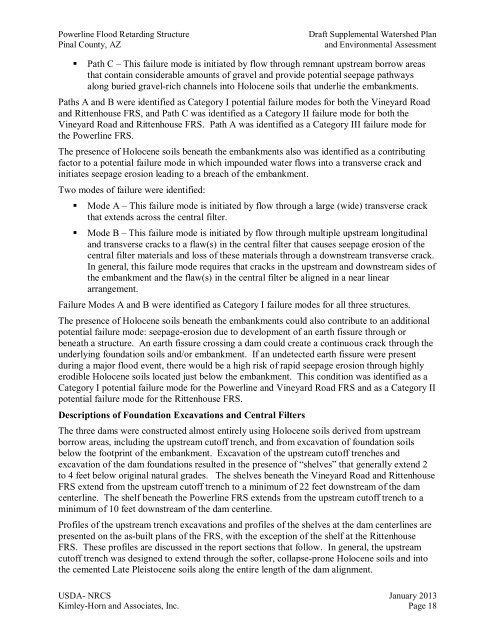Powerline Plan and Environ. Assessment Jan. 2013 - Flood Control ...
Powerline Plan and Environ. Assessment Jan. 2013 - Flood Control ...
Powerline Plan and Environ. Assessment Jan. 2013 - Flood Control ...
Create successful ePaper yourself
Turn your PDF publications into a flip-book with our unique Google optimized e-Paper software.
<strong>Powerline</strong> <strong>Flood</strong> Retarding Structure<br />
Pinal County, AZ<br />
Draft Supplemental Watershed <strong>Plan</strong><br />
<strong>and</strong> <strong>Environ</strong>mental <strong>Assessment</strong><br />
• Path C – This failure mode is initiated by flow through remnant upstream borrow areas<br />
that contain considerable amounts of gravel <strong>and</strong> provide potential seepage pathways<br />
along buried gravel-rich channels into Holocene soils that underlie the embankments.<br />
Paths A <strong>and</strong> B were identified as Category I potential failure modes for both the Vineyard Road<br />
<strong>and</strong> Rittenhouse FRS, <strong>and</strong> Path C was identified as a Category II failure mode for both the<br />
Vineyard Road <strong>and</strong> Rittenhouse FRS. Path A was identified as a Category III failure mode for<br />
the <strong>Powerline</strong> FRS.<br />
The presence of Holocene soils beneath the embankments also was identified as a contributing<br />
factor to a potential failure mode in which impounded water flows into a transverse crack <strong>and</strong><br />
initiates seepage erosion leading to a breach of the embankment.<br />
Two modes of failure were identified:<br />
• Mode A – This failure mode is initiated by flow through a large (wide) transverse crack<br />
that extends across the central filter.<br />
• Mode B – This failure mode is initiated by flow through multiple upstream longitudinal<br />
<strong>and</strong> transverse cracks to a flaw(s) in the central filter that causes seepage erosion of the<br />
central filter materials <strong>and</strong> loss of these materials through a downstream transverse crack.<br />
In general, this failure mode requires that cracks in the upstream <strong>and</strong> downstream sides of<br />
the embankment <strong>and</strong> the flaw(s) in the central filter be aligned in a near linear<br />
arrangement.<br />
Failure Modes A <strong>and</strong> B were identified as Category I failure modes for all three structures.<br />
The presence of Holocene soils beneath the embankments could also contribute to an additional<br />
potential failure mode: seepage-erosion due to development of an earth fissure through or<br />
beneath a structure. An earth fissure crossing a dam could create a continuous crack through the<br />
underlying foundation soils <strong>and</strong>/or embankment. If an undetected earth fissure were present<br />
during a major flood event, there would be a high risk of rapid seepage erosion through highly<br />
erodible Holocene soils located just below the embankment. This condition was identified as a<br />
Category I potential failure mode for the <strong>Powerline</strong> <strong>and</strong> Vineyard Road FRS <strong>and</strong> as a Category II<br />
potential failure mode for the Rittenhouse FRS.<br />
Descriptions of Foundation Excavations <strong>and</strong> Central Filters<br />
The three dams were constructed almost entirely using Holocene soils derived from upstream<br />
borrow areas, including the upstream cutoff trench, <strong>and</strong> from excavation of foundation soils<br />
below the footprint of the embankment. Excavation of the upstream cutoff trenches <strong>and</strong><br />
excavation of the dam foundations resulted in the presence of “shelves” that generally extend 2<br />
to 4 feet below original natural grades. The shelves beneath the Vineyard Road <strong>and</strong> Rittenhouse<br />
FRS extend from the upstream cutoff trench to a minimum of 22 feet downstream of the dam<br />
centerline. The shelf beneath the <strong>Powerline</strong> FRS extends from the upstream cutoff trench to a<br />
minimum of 10 feet downstream of the dam centerline.<br />
Profiles of the upstream trench excavations <strong>and</strong> profiles of the shelves at the dam centerlines are<br />
presented on the as-built plans of the FRS, with the exception of the shelf at the Rittenhouse<br />
FRS. These profiles are discussed in the report sections that follow. In general, the upstream<br />
cutoff trench was designed to extend through the softer, collapse-prone Holocene soils <strong>and</strong> into<br />
the cemented Late Pleistocene soils along the entire length of the dam alignment.<br />
USDA- NRCS <strong>Jan</strong>uary <strong>2013</strong><br />
Kimley-Horn <strong>and</strong> Associates, Inc. Page 18













